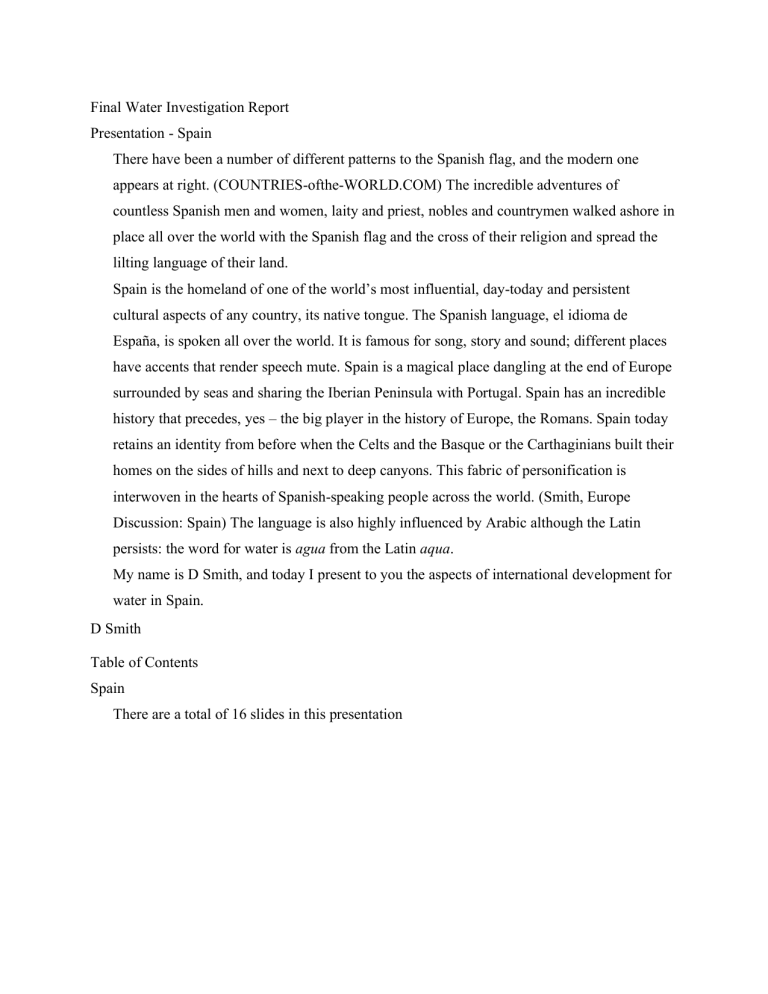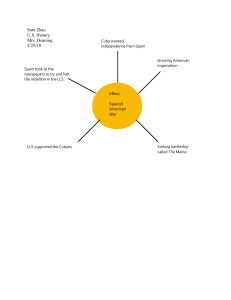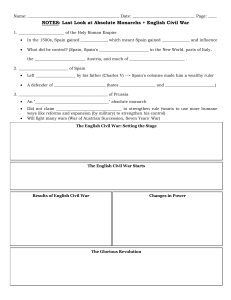
Final Water Investigation Report Presentation - Spain There have been a number of different patterns to the Spanish flag, and the modern one appears at right. (COUNTRIES-ofthe-WORLD.COM) The incredible adventures of countless Spanish men and women, laity and priest, nobles and countrymen walked ashore in place all over the world with the Spanish flag and the cross of their religion and spread the lilting language of their land. Spain is the homeland of one of the world’s most influential, day-today and persistent cultural aspects of any country, its native tongue. The Spanish language, el idioma de España, is spoken all over the world. It is famous for song, story and sound; different places have accents that render speech mute. Spain is a magical place dangling at the end of Europe surrounded by seas and sharing the Iberian Peninsula with Portugal. Spain has an incredible history that precedes, yes – the big player in the history of Europe, the Romans. Spain today retains an identity from before when the Celts and the Basque or the Carthaginians built their homes on the sides of hills and next to deep canyons. This fabric of personification is interwoven in the hearts of Spanish-speaking people across the world. (Smith, Europe Discussion: Spain) The language is also highly influenced by Arabic although the Latin persists: the word for water is agua from the Latin aqua. My name is D Smith, and today I present to you the aspects of international development for water in Spain. D Smith Table of Contents Spain There are a total of 16 slides in this presentation Subject of the Investigation, 1 Slide Background, 2 Slides Three Innovations, 1 Slide Findings – Water Source: (Topic 12) 4 Slides Findings – Society: (Topic 7) 4 Slides Opinion – Conclusion: Water Source: (Topic 12) 1 Slide Opinion – Conclusion: Society: (Topic 7), 1 Slide Subject of the Investigation: The world region for Spain is Europe. The two topics and associated questions for Spain are listed here: Water Source: (12) What are the sources of water in Spain? What is the origin of the water in Spain? Society: (7) How are people educated in Spain about water? What do they know about its origins and purposes? The world region for Spain is Europe. The two topics and associated questions for Spain are listed here: Water Source: (12) What are the sources of water in Spain? What is the origin of the water in Spain? Society: (7) How are people educated in Spain about water? What do they know about its origins and purposes? Background 1: Spain Spain is about 1/2 million square kilometers (505,370 km2) or 195 thousand square miles (195,124 mi2) and is the 53th largest country in the world. Spain has a population of 49 million people (49,958,159 (July 2017)) and is the 28th most populous country in the world. (Central Intelligence Agency) Many of the larger western European countries can be more readily compared by population density: Britain is the highest with 395 persons per km2, then Germany at 230 persons per km2, France at 122 persons per km2 and Spain at 91 persons per km2. The size of the country: Spain is about 1/2 million square kilometers (505,370 km2) or 195 thousand square miles (195,124 mi2) and is the 53th largest country in the world. (Central Intelligence Agency) The population size of the country: Spain has a population of 49 million people (49,958,159 (July 2017)) and is the 28th most populous country in the world. (Central Intelligence Agency) Background 2: Spain Spain’s largest imports are vehicles. Spain imports 46 billion US Dollars worth of vehicles. It’s US$45.9 billion and 13.1% of Spain’s total imports. (Workman, Spain’s Top 10 Imports) It interesting to note that it is less than the top export, which is vehicles at US$57.0 billion. In 2017, Spain exported US$320.1 billion worth of goods, 70% of it to Europe and just 3% to Latin American (except Mexico) (Workman, Spain’s Top 10 Exports) where most of the other Spanish speaking countries are. One would think that there would be closer ties, but since Spain produces cars much as the Latin American countries do, is much further away from Europe, then there’s just not much trade between them. The country’s largest import and largest export: Spain’s largest imports are vehicles. Spain imports 46 billion US Dollars worth of vehicles. It’s US$45.9 billion and 13.1% of Spain’s total imports. (Workman, Spain’s Top 10 Imports) It interesting to note that it is less than the top export, which is vehicles at US$57.0 billion. In 2017, Spain exported US$320.1 billion worth of goods, 70% of it to Europe and just 3% to Latin American (except Mexico) (Workman, Spain’s Top 10 Exports) where most of the other Spanish speaking countries are. One would think that there would be closer ties, but since Spain produces cars much as the Latin American countries do, is much further away from Europe, then there’s just not much trade between them. Three Innovations Spain The three water innovations in Spain, discussed in this paper, are: Rain (Climate) Rivers (Watersheds) Wind and Water (Technology) The precipitation in Spain varies across the Iberian peninsula. Since there are three different coastlines: the north is on the Bay of Biscay, the southwest is on the Atlantic, and the east and south is on the Mediterranean Sea, weather and climate reflect their region. The center is hot and often dry. The rivers in Spain are characterized by uniformity to a greater degree. The five larger rivers and their watersheds are all roughly the same size. The smaller rivers drain directly to the seas. The history of windmills in Spain is commonplace, but the modern implications of renewable energy technology is equally significant if not more urgently applicable. Spain sports some technology, seemingly useful in it far away location, on an island in the Atlantic, which may hallmark how wind and water can be utilized together. Rain (Climate) Rivers (Watersheds) Wind and Water (Technology) Findings - Water Source 1: Spain The two topics, sources of water (Topic 12) and society of Spain (Topic 7), are like the loom from which the fabric of Spain is spun and how water is the thread to weave and bind this land together. (Smith, Europe Discussion: Spain) The Water Source topic has two questions and are answered together for each innovation. The origin of the water in Spain is in the mountains, and the sources of water are the rivers. Whether it’s the origin or the source, the water comes from the rain and snow. Water Source: (Topic 12) The Water Source topic has two questions and are answered together for each innovation. What is the origin and the sources of water in Spain? Findings - Water Source 2: Spain The rain falls in Castile and León, the land of castles and lions emblazoned on the national shield. There’s the winter snows, cold and wet in the mountains in Aragon and Andalusia, both north and south, in Navarre and across windswept Extremadura. (Smith, Europe Discussion: Spain) An overall look at Spain’s climate includes the precipitation map (Gómez-Miguel) and the one with the Köppen climate classification system. The idea is to compare the .two maps and correlate how the weather and climate provide for the ample Spanish Watersheds. The Köppen climate classification system map, above, has a legend at the bottom left. It also shows where there are mountains. These are the blue patches and do not correspond to the colors at left except a little because we know that mountains provide for different climates; they're microclimates. It also has the rivers. The climate differences between the two maps is clear: it shows that Spain has both a north/south and a west/east climate configuration. Water Source: (Topic 12) What is the origin and the sources of water in Spain? Rain (Climate) (Sáez, Geological Map of the Iberian Peninsula.) (Smith, Europe Discussion: Spain, The Climate) Findings - Water Source 3: Spain The rivers of Spain are an amazing thing. OK, well, how so if Spain is just one of many countries in Europe with famous rivers? France has the Seine and the Rhone; Germany has the Rhine and the Danube, Russia has the Volga and Don; England has the Thames. Spain's rivers are Ebro, Júcar and Segura - all of which flow to the east into the Mediterranean Sea and are listed from north to south. The Miño, Duero, Tajo, Guadiana and Guadalquivir flow into the Atlantic; some go through Portugal. Some are short, and some are long with deep channels. Show the pattern of the geomorphology of the country. The part that's different when it comes to Spanish rivers, the ones that both divide and unite the nation, is that these are somewhat unknown outside Spain (and Portugal) and don't readily affect other countries other than the ones that flow through Portugal. It's because these rivers rise and discharge all within and along the coast of the Iberian Peninsula. These rivers create and dictate the character of each region of Spain. The other big rivers in Europe, yes even the Seine (Paris) and the ones in Russia (both Baltic and Black seas) have many other influences that merge to personify them whereas the ones in Spain are, each due to its concentrated geography, are both distinct and adjacent. Water Source: (Topic 12) What is the origin and the sources of water in Spain? Rivers (Watersheds) (Smith, Europe Discussion: Spain, The Rivers) The topographical map of Spain (Sáez, Topographical Map of the Iberian Peninsula Spain) and the map of the watersheds (Rodeles, Galicia and Miranda) (Smith, Europe Discussion: Spain, The Rivers) Findings - Water Source 4: Spain The windmills of Consuegra in Spain do not pump water as is done all over world (from tiny windmills filling stock tanks from a well on a ranch in Colorado to big ones draining polders in Holland) they grind grain. The remarkable history of windmills has a Spanish connection through the time of the Arabic expansion all the way past the Pyrenees and lasting about 700 years on the peninsula. Around the turn of the first millennium, the renown geographer Ali al-Mas’udi wrote about craftsmen who had “boasted about being able to build a mill driven by the wind, to which he received the reply, “By God, I will build this mill of which the World will talk” and “...the land of winds and sand. There the wind drives mills and raises water from the streams, whereby gardens are irrigated. There is in the world, and God alone knows it, no place where more frequent use is made of the winds.” The technology was not lost through the ages; it persisted on the high plateau of Castile and in the 21st century in the Canary Islands. Water Source: (Topic 12) What is the origin and the sources of water in Spain? Wind and Water (Technology) Windsmills (Smith, Europe Discussion: Spain, Wind and Water) (Shepherd 7) Findings - Society 1: Spain The Society topic has two questions and are answered together for each innovation. How are people educated in Spain about water, and what do they know about its origins and purposes? People are educated in Spain about water from their infant days, and they know quite a bit about the origin and purposes of water. The society of Spain is one tied to the land, the wind, the heavens and the sky with a constant thread: wine making. Society: (Topic 7) The Society topic has two questions and are answered together for each innovation. How are people educated in Spain about water, and what do they know about its origins and purposes? Findings - Society 2: Spain Language and vocabulary are intertwined “Terruño is the spanish term employed in viticulture to designate the set of special characteristics that the geography, geology and climate of a certain place, interacting with the plant genetics, expressed in agricultural products such as wine. In English, terruño can be very loosely translated as "a sense of place," which is embodied in certain characteristic qualities, the sum of the effects that the local environment has had on the production of the wine.” (Sáez) This word captures so much embodied in the culture of Spain. Pedro Benito Sáez maintains a website dedicated to Spanish vinticulture. In it, he writes, “The climate is the factor that exerts the greatest influence in the development of the vine. The way general climatic characteristics are modified by the local terrain is what defines the mesoclimate” Society: (Topic 7) How are people educated in Spain about water, and what do they know about its origins and purposes? Rain (Climate) Terruño (Sáez) Findings - Society 3: Spain The rivers and valleys of Spain, whether the Ebro or Guadiana, the Tajo or the Duero or the Quadalquivir. Spanish society is tied to the vine, and the vine is tied to the land. “Although vines readily adapt to numerous soil types, the suitability of soils for viticulture is defined by their geological origin. The soil’s depth is the first determining factor of the grapevine’s development potential, because it will determine the volume of soil occupied by the roots and, therefore, the amount of available water and nutrients. Within the same wine region, the concept of climate can be greatly influenced by conditioning aspects such as altitude, slopes, valley depths, proximity of water masses or wooded areas, winds, etc.” and "Spain is a wine country transformed by quality, a fusion between the traditional and the trendsetting that delivers incomparable variety and value. With the largest number of vineyards of any country in the world, Spain offers and embarrassment of wine riches, and choosing just 36 from the thousands of samples.” Society: (Topic 7) How are people educated in Spain about water, and what do they know about its origins and purposes? Rivers (Watersheds) Ebro Guadiana Tajo Duero Quadalquivir (Sáez) Findings - Society 4: Spain Still, the image stuck with me, and then I discovered the equally tiny (think isolated) El Hierro, one Spain's Canary Islands. This place is a barren, edge-of-the-world (even more so in Cervantes's time 400 years ago) perched on one of the island chain of volcanos, and never connected to, well- anything. “Before Columbus set sail, this island was the westernmost point of the known world. The only way they got electricity here is by shipping in thousands of tons of diesel fuel by barge; an expensive and dirty endeavor until now: five massive, metal turbines, windmills that are powering the entire island's electricity.” Just recently, El Hierro inaugurated the Gorona del Viento power station. It is powered by wind turbines, and the excess electricity is stored in the form of water pumped up the side of a mountain and into a volcanic crater. El Hierro was never connected to the Spanish electrical grid. The island formerly generated electricity by powering diesel engines. Now this way out there island is way out in front of the tech innovation curve; it wind and water powered: 100% renewable, carbon free clean energy. It's dependable too, so says my source. The society of El Hierro has come see the future, literally, after isolation gives them an identity. “The plant consists of five windmills and two lakes; one at the top of the mountain and one below, connected with a big tube. So when there's enough wind, we use the windmills to power the island and to pump water from the bottom lake up to the top one. Then if the wind dies down, that water is released down through turbines and generates hydroelectric power.” (Qunitero) Society: (Topic 7) How are people educated in Spain about water, and what do they know about its origins and purposes? Wind and Water (Technology) El Hierro (Qunitero) (Smith, Europe Discussion: Spain, Wind and Water) Opinion – Conclusion 1: Spain I write my conclusion fresh with the thoughts of Spain and memories of my trip there. It was so different from France but I soon became accustomed to the slow pace and the agrarian lifestyle of the Spanish countryside; then, there was the running with the bulls. A lot of people drank wine during the fiesta in Pamplona. I drank some too but was careful not to be slow and stumbly at 8:00 in the morning, for the running! I examine nature of how the climate of Spain is interwoven with the countryside. The rivers are drainages in their respective watersheds and smaller in size than the whole of Spain although it’s a natural division of the topography. The technology of the wind powered and pump water reservoirs is something that I spend time thing about myself. If we could only do this here, in Colorado. Water Source: (12) The sources of water in Spain are the rivers. The rivers get the water from the mountain snow and rain all across the plain. It is a delight to see the thunderstorm against the rocks. Rain (Climate) Rivers (Watersheds) Wind and Water (Technology) Opinion - Conclusion The climate of Spain, the society and viticulture go hand-in-hand to the table. The geology of Spain and the soil makes for a place to grow grapes and make wine for the vibrant Spanish society A comparison of the history of the isolated island of El Hierro with the modern trechnology that frees it from dependence on fossil fuels is inspirational. I should just go there a see this for myself. Society: (7) People live the relationship in Spain with water by living in its abundance, if not volumes, then the produce that comes from it. Rain (Climate) Rivers (Watersheds) Wind and Water (Technology)


